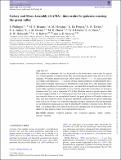Galaxy And Mass Assembly (GAMA) : time-scales for galaxies crossing the green valley
Abstract
We explore the constraints that can be placed on the evolutionary time-scales for typical low-redshift galaxies evolving from the blue cloud through the green valley and on to the red sequence. We utilize galaxies from the GAMA survey with 0.1 < z < 0.2 and classify them according to the intrinsic (u* − r*) colours of their stellar populations, as determined by fits to their multiwavelength spectral energy distributions. Using these fits to also determine stellar population ages and star formation time-scales, we argue that our results are consistent with a green valley population dominated by galaxies that are simply decreasing their star formation (running out of gas) over a time-scale of 2–4 Gyr which are seen at a specific epoch in their evolution (approximately 1.6 e-folding times after their peak in star formation). If their fitted star formation histories are extrapolated forward, the green galaxies will further redden over time, until they attain the colours of a passive population. In this picture, no specific quenching event which cuts-off their star formation is required, though it remains possible that the decline in star formation in green galaxies may be expedited by internal or external forces. However, there is no evidence that green galaxies have recently changed their star formation time-scales relative to their previous longer term star formation histories.
Citation
Phillipps , S , Bremer , M N , Hopkins , A M , De Propris , R , Taylor , E N , James , P A , Davies , L J M , Cluver , M , Driver , S P , Eales , S A , Holwerda , B W , Kelvin , L S & Sansom , A E 2019 , ' Galaxy And Mass Assembly (GAMA) : time-scales for galaxies crossing the green valley ' , Monthly Notices of the Royal Astronomical Society , vol. 485 , no. 4 , pp. 5559–5572 . https://doi.org/10.1093/mnras/stz799
Publication
Monthly Notices of the Royal Astronomical Society
Status
Peer reviewed
ISSN
0035-8711Type
Journal article
Collections
Items in the St Andrews Research Repository are protected by copyright, with all rights reserved, unless otherwise indicated.
Related items
Showing items related by title, author, creator and subject.
-
SDSS-IV MaNGA: How the stellar populations of passive central galaxies depend on stellar and halo mass
Oyarzún, Grecco A.; Bundy, Kevin; Westfall, Kyle B.; Tinker, Jeremy L.; Belfiore, Francesco; Argudo-Fernández, Maria; Zheng, Zheng; Conroy, Charlie; Masters, Karen L.; Wake, David; Law, David R.; McDermid, Richard M.; Aragón-Salamanca, Alfonso; Parikh, Taniya; Yan, Renbin; Bershady, Matthew; Sánchez, Sebastián F.; Andrews, Brett H.; Fernández-Trincado, José G.; Lane, Richard R.; Bizyaev, D.; Boardman, Nicholas Fraser; Lacerna, Ivan; Brownstein, J. R.; Drory, Niv; Zhang, Kai (2022-07-06) - Journal articleWe analyze spatially resolved and co-added SDSS-IV MaNGA spectra with signal-to-noise ratio ∼100 from 2200 passive central galaxies (z ∼ 0.05) to understand how central galaxy assembly depends on stellar mass (M*) and halo ... -
Secular-and merger-built bulges in barred galaxies
Mendez Abreu, Jairo; Debattista, V. P.; Corsini, E. M.; Aguerri, J. A. L. (2014-12) - Journal articleContext. Historically, galaxy bulges were thought to be single-component objects at the center of galaxies. However, this picture is now questioned since different bulge types with different formation paths, namely classical ... -
Galaxy And Mass Assembly (GAMA) : galaxy close pairs, mergers and the future fate of stellar mass
Robotham, A. S. G.; Driver, S. P.; Davies, L. J. M.; Hopkins, A. M.; Baldry, I. K.; Agius, N. K.; Bauer, A. E.; Bland-Hawthorn, J.; Brough, S.; Brown, M. J. I.; Cluver, M.; De Propris, R.; Drinkwater, M. J.; Holwerda, B. W.; Kelvin, L. S.; Lara-Lopez, M. A.; Liske, J.; Lopez-Sanchez, A. R.; Loveday, J.; Mahajan, S.; McNaught-Roberts, T.; Moffett, A.; Norberg, P.; Obreschkow, D.; Owers, M. S.; Penny, S. J.; Pimbblet, K.; Prescott, M.; Taylor, E. N.; van Kampen, E.; Wilkins, S. M. (2014-11-11) - Journal articleWe use a highly complete subset of the Galaxy And Mass Assembly II (GAMA-II) redshift sample to fully describe the stellar mass dependence of close pairs and mergers between 10(8) and 10(12)M(circle dot). Using the analytic ...

